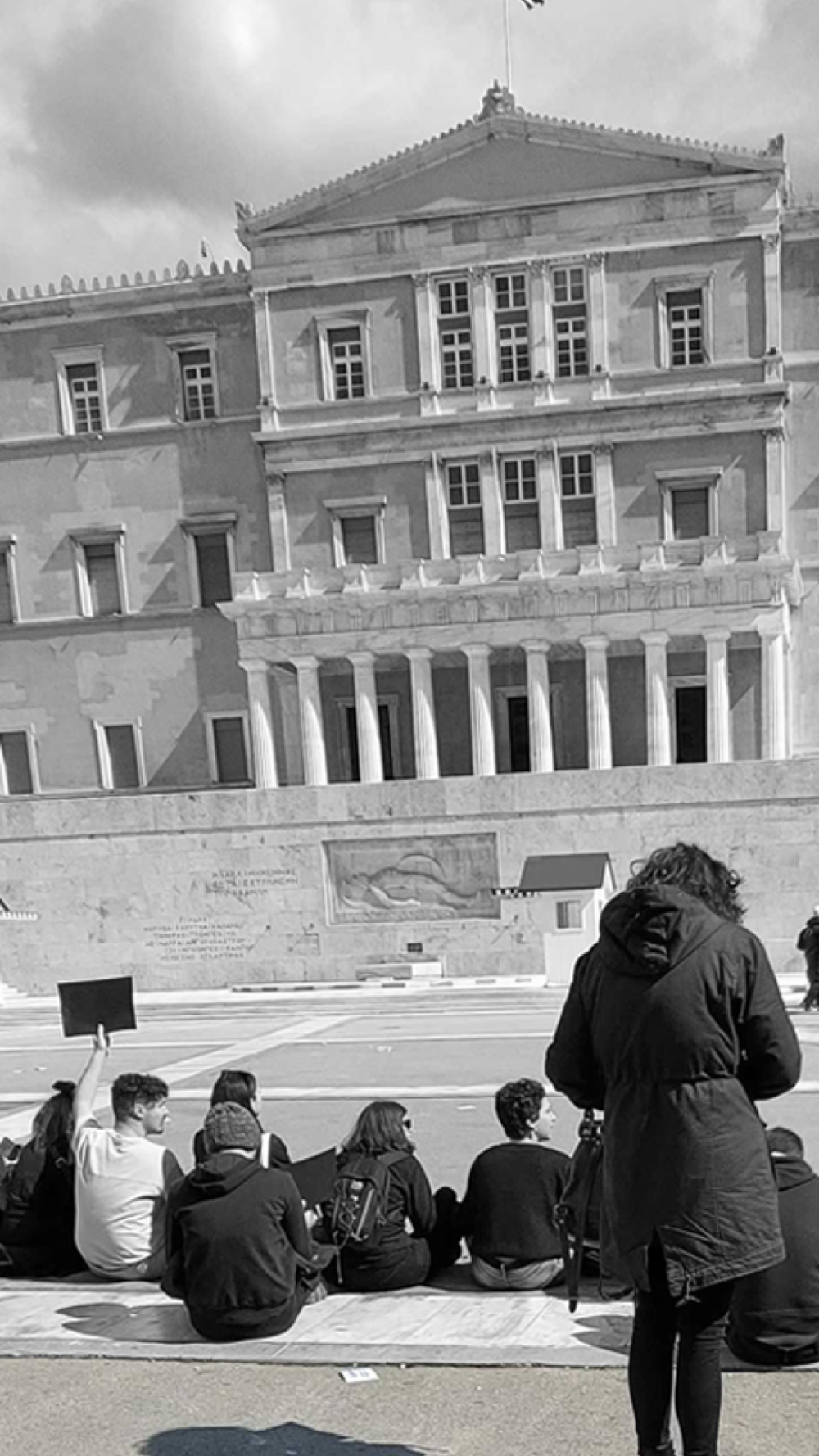
Responses to the pandemic are shaping a new political generation
On October 15, 2011, protesters took to the streets of 951 cities in 82 countries, from the United States and Latin America to Europe and Asia. This was the tipping point, after many months marked by mobilizations and riots around the world. A common denominator of all was the dissatisfaction over the economic policies that emerged after the global financial crisis of 2008. At the same time and in such a socio-economic environment, Millennials took their first steps into adulthood while Generation Z was entering adolescence.
According to Keir Milburn, professor of political economy 1 and author of the book “Generation Left”, 2 these events were decisive for the political, ideological, and demographic formation of the new generation.
In our interview with Keir Milburn for Eteron, we had the opportunity to discuss some of the ideas he has put forward in the international debate on generations. In addition, we elaborated on recent tendencies and developments during the pandemic.
Since 2019, when his book was published, until today, Milburn has been a frequent guest on podcasts, has participated in many events of institutes and research projects on the new generations, 3 and has written extensively in newspapers and alternative media, such as Novara Media, 4 in which he is the co-presenter of the show #ACFM. 5
Milburn’s key position is that age has now become the most reliable predictor of somebody’s political opinions and voting intentions.
It turns out, thus, that young people today are much more likely to have leftist views and to vote for left-wing parties, as opposed to the conservative views and corresponding electoral behavior of the older generations. Although there is often a sense that this is a timeless phenomenon, he argues that the situation has not always been this way. 6
In his interview, Milburn demonstrates that a crucial factor in analyzing this phenomenon is the economic gap between the younger and the older generations, which was exacerbated since the 2008 global financial crisis. Focusing on countries such as the US and the UK, he explains that young workers who are largely cut off from home ownership, dependent on the level of wages and exposed to increased costs of living, have been facing a different material reality than the one of elderly property owners.
These different realities and experiences thus created a “divergence in images of the future” as Milburn describes. “In my book I argue that this combined but uneven collapse of neoliberal aspiration has led to a crisis in the way young people make sense of the world. As a result, the nascent generation of 2008 is large and disgruntled, but it is also politically ambiguous” Milburn says.
According to him, this is the basis of the electoral turn that took place in the second half of 2010, with the youth supporting political projects such as that of Sanders and Corbyn in the US and the UK, respectively.
By the time Milburn’s book “Generation Left” was completed, the Covid-19 pandemic had not yet appeared. For this reason, we asked him to share with us some of his thoughts on the impact of the new situation on the political formation of the Millennials and Generation Z. In other words, if the financial crisis of 2008 set the conditions for the emergence of Generation Left, could the pandemic and its economic effects produce a new political generation?
Milburn argues that the Covid pandemic is one of those events that can produce significant political effects. As the large differences in resources, prospects and material interests remain, he estimates that it seems quite likely that these effects will take on generational dimensions. At present, the situation seems to be contradictory. On the one hand, there have been significant signs of solidarity between young people and the older generations. On the other hand, the impact of what is happening today is likely to widen the generation gap in the future:
“While the old are more at risk of suffering serious consequences and even death from Covid infections it is the young who have borne the heaviest costs of social distancing both in terms of income and reduced social lives. While, overall, this burden seems to have been willingly borne the longer-term economic and so political effects of the pandemic are more uncertain” he explains.
At the same time, Milburn believes that what is happening during the last couple of years will leave a deeper imprint on the new generation and will play a key role in formulating its future political demands and its conception of freedom:
“One political dimension the pandemic has brought to the fore is a growing division around different senses of what freedom consists of. It’s something that is likely to persist as both the pandemic and the climate crisis are immediately planetary in scale and reveal our intimate interdependence with other human and non-human actors. As such they problematise a particular, neoliberal conception of freedom as a sense of autonomy from others, indeed, as the ability to act without the need to consider others. It’s a sense of autonomy that rests on the obscuring of the reproductive and infrastructural work of others which enables it. The risk of infection momentarily brought such ‘essential work’ to the fore as the working conditions of those performing it became an important possible vector of infection. Similarly, social distancing, vaccination and activities that produce carbon emissions all make clear that our actions impact others and vice versa.”
This experience, in Milburn’s view, is likely to lead to a more democratic conception of freedom in the future, as well as to the search for solutions that can help bridge the generation divide.

One of the criticisms over Milburn’s Generation Left thesis concerns the adoption of an “over-optimistic” conception of the political formation of the younger generation. Milburn argues that behind such critiques is lurking the wrong assumption of some sort of automatic connection between social position and political consciousness. These assumptions, Milburn continues, follow from a core component of contemporary political common sense, implying that the unfavorable economic conditions experienced by the younger generations automatically make them more radical in a progressive direction.
Milburn draws on his analysis of Mannheim’s theoretical work on generations. The classic theorist of generations, Karl Mannheim, argues that events which produce generation forming conditions also produce different generational units (e.g. on the left-right axis). If a coherent political generation is to be formed, then one of those units must become hegemonic in relation to its contemporaries.
In this regard, Milburn develops the position that large-scale events “can become generation forming if they impact in a generationally uneven manner on what seems possible, if they alter assumptions about what the future could look like”.
He argues, then, that material living conditions are nothing more than the basis on which different political narratives can be built:
“We should instead think of lived experience, for instance the shared lived experience of deteriorating conditions and prospects among many young people through the 2010s, as the raw material from which several different political projects could be created”.
Within this process Milburn describes the production of left “generational units” in many countries and the formation of the Generation Left during the past decade.
At the same time, he admits that the wave of optimism that prevailed in early 2019, when the book was published, has begun to subside. At the time, Generation Left appeared to be winning. Jeremy Corbyn, after the encouraging results of 2017, seemed close to electoral victory. So did Bernie Sanders in the presidential race: “These ageing leftwing leaders had rallied young voters in each of their respective countries, allowing the shift left among the youth to accelerate and become visible”. However, the defeat of both changed the big picture, bringing to the fore a new wave of uncertainty about the future directions of the new generation.
In any case, while it remains unclear what will happen in the post-pandemic period, Milburn’s argument reflects the challenge of the feeling that “there’s a North-East passage to a better world which can bypass the treacherous field of political action”. The latter, as he told us, “is one of the core fantasies of our time”.
As he concludes, the Generation Left phenomenon represents “an opening in history” and refers “not only to the current left tendency of the young, but also to the political project to develop and assert a new left politics adequate to its experiences”.
Footnotes
- Keir Milburn has taught at the University of Leicester. He collaborates with the Rosa Luxemburg Foundation in London on issues of publicity, economic democracy and political economy[↩]
- Keir Milburn, Generation Left (Polity, 2019) [↩]
- The World Transformed, ‘What is Generation Left?’, 28/9/2021; DigiGen webinar, “The digital generation’s political voices”, 26/5/2021[↩]
- Keir Milburn, ‘The Pandemic is Changing How It Feels to Be Free’, Novara Media, 6/1/2020 [↩]
- #ACFM is a podcast on Novara Media, presented by Milburn with Nadia Idle and Jeremy Gilbert. The range of their topics covers, beside others, “left politics, culture, music and experiences of collective joy”[↩]
- According to Ipsos MORI, in Thatcher’s election victory in 1983, the Conservatives took the lead with 42% in the 18-24 age group, 9 points ahead the Labour Party, [↩]



